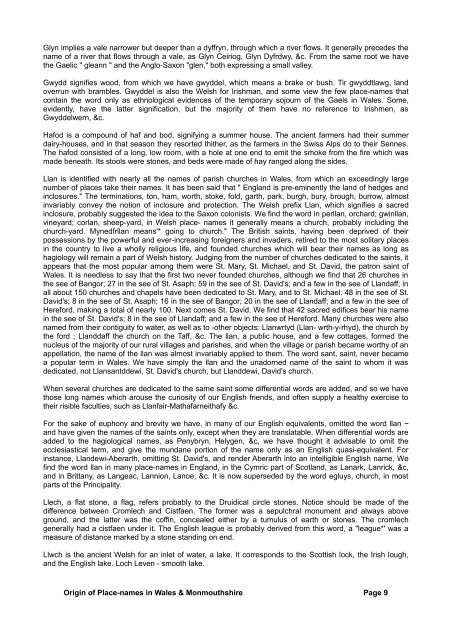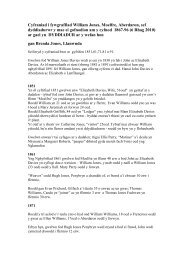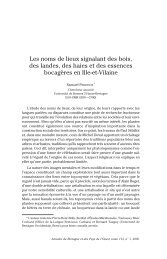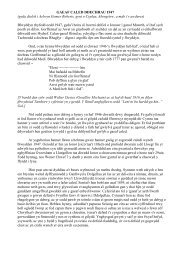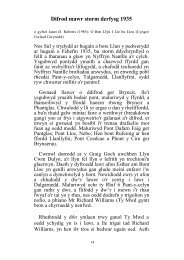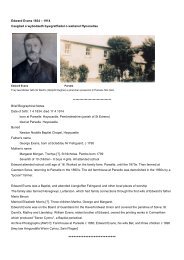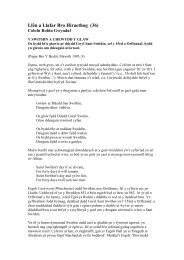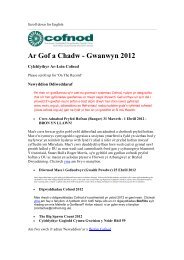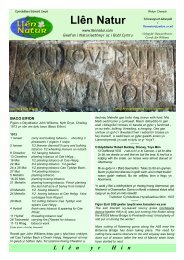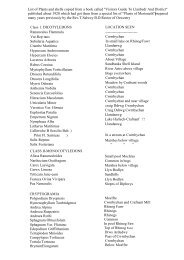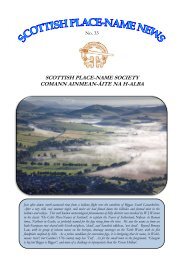handbook of the origin of place-names in wales and monmouthshire
handbook of the origin of place-names in wales and monmouthshire
handbook of the origin of place-names in wales and monmouthshire
- No tags were found...
Create successful ePaper yourself
Turn your PDF publications into a flip-book with our unique Google optimized e-Paper software.
Glyn implies a vale narrower but deeper than a dyffryn, through which a river flows. It generally precedes <strong>the</strong>name <strong>of</strong> a river that flows through a vale, as Glyn Ceiriog, Glyn Dyfrdwy, &c. From <strong>the</strong> same root we have<strong>the</strong> Gaelic " gleann " <strong>and</strong> <strong>the</strong> Anglo-Saxon "glen," both express<strong>in</strong>g a small valley.Gwydd signifies wood, from which we have gwyddel, which means a brake or bush. Tir gwyddtlawg, l<strong>and</strong>overrun with brambles. Gwyddel is also <strong>the</strong> Welsh for Irishman, <strong>and</strong> some view <strong>the</strong> few <strong>place</strong>-<strong>names</strong> thatconta<strong>in</strong> <strong>the</strong> word only as ethnological evidences <strong>of</strong> <strong>the</strong> temporary sojourn <strong>of</strong> <strong>the</strong> Gaels <strong>in</strong> Wales. Some,evidently, have <strong>the</strong> latter signification, but <strong>the</strong> majority <strong>of</strong> <strong>the</strong>m have no reference to Irishmen, asGwyddelwern, &c.Hafod is a compound <strong>of</strong> haf <strong>and</strong> bod, signify<strong>in</strong>g a summer house. The ancient farmers had <strong>the</strong>ir summerdairy-houses, <strong>and</strong> <strong>in</strong> that season <strong>the</strong>y resorted thi<strong>the</strong>r, as <strong>the</strong> farmers <strong>in</strong> <strong>the</strong> Swiss Alps do to <strong>the</strong>ir Sennes.The hafod consisted <strong>of</strong> a long, low room, with a hole at one end to emit <strong>the</strong> smoke from <strong>the</strong> fire which wasmade beneath. Its stools were stones, <strong>and</strong> beds were made <strong>of</strong> hay ranged along <strong>the</strong> sides.Llan is identified with nearly all <strong>the</strong> <strong>names</strong> <strong>of</strong> parish churches <strong>in</strong> Wales, from which an exceed<strong>in</strong>gly largenumber <strong>of</strong> <strong>place</strong>s take <strong>the</strong>ir <strong>names</strong>. It has been said that " Engl<strong>and</strong> is pre-em<strong>in</strong>ently <strong>the</strong> l<strong>and</strong> <strong>of</strong> hedges <strong>and</strong><strong>in</strong>closures." The term<strong>in</strong>ations, ton, ham, worth, stoke, fold, garth, park, burgh, bury, brough, burrow, almost<strong>in</strong>variably convey <strong>the</strong> notion <strong>of</strong> <strong>in</strong>closure <strong>and</strong> protection. The Welsh prefix Llan, which signifies a sacred<strong>in</strong>closure, probably suggested <strong>the</strong> idea to <strong>the</strong> Saxon colonists. We f<strong>in</strong>d <strong>the</strong> word <strong>in</strong> perllan, orchard; gw<strong>in</strong>llan,v<strong>in</strong>eyard; corlan, sheep-yard, <strong>in</strong> Welsh <strong>place</strong>- <strong>names</strong> it generally means a church, probably <strong>in</strong>clud<strong>in</strong>g <strong>the</strong>church-yard. Mynedfrllan means'* go<strong>in</strong>g to church." The British sa<strong>in</strong>ts, hav<strong>in</strong>g been deprived <strong>of</strong> <strong>the</strong>irpossessions by <strong>the</strong> powerful <strong>and</strong> ever-<strong>in</strong>creas<strong>in</strong>g foreigners <strong>and</strong> <strong>in</strong>vaders, retired to <strong>the</strong> most solitary <strong>place</strong>s<strong>in</strong> <strong>the</strong> country to live a wholly religious life, <strong>and</strong> founded churches which will bear <strong>the</strong>ir <strong>names</strong> as long ashagiology will rema<strong>in</strong> a part <strong>of</strong> Welsh history. Judg<strong>in</strong>g from <strong>the</strong> number <strong>of</strong> churches dedicated to <strong>the</strong> sa<strong>in</strong>ts, itappears that <strong>the</strong> most popular among <strong>the</strong>m were St. Mary, St. Michael, <strong>and</strong> St. David, <strong>the</strong> patron sa<strong>in</strong>t <strong>of</strong>Wales. It is needless to say that <strong>the</strong> first two never founded churches, although we f<strong>in</strong>d that 26 churches <strong>in</strong><strong>the</strong> see <strong>of</strong> Bangor; 27 <strong>in</strong> <strong>the</strong> see <strong>of</strong> St. Asaph; 59 <strong>in</strong> <strong>the</strong> see <strong>of</strong> St. David's; <strong>and</strong> a few <strong>in</strong> <strong>the</strong> see <strong>of</strong> Ll<strong>and</strong>aff; <strong>in</strong>all about 150 churches <strong>and</strong> chapels have been dedicated to St. Mary, <strong>and</strong> to St. Michael: 48 <strong>in</strong> <strong>the</strong> see <strong>of</strong> St.David's; 8 <strong>in</strong> <strong>the</strong> see <strong>of</strong> St. Asaph; 16 <strong>in</strong> <strong>the</strong> see <strong>of</strong> Bangor; 20 <strong>in</strong> <strong>the</strong> see <strong>of</strong> Ll<strong>and</strong>aff; <strong>and</strong> a few <strong>in</strong> <strong>the</strong> see <strong>of</strong>Hereford, mak<strong>in</strong>g a total <strong>of</strong> nearly 100. Next comes St. David. We f<strong>in</strong>d that 42 sacred edifices bear his name<strong>in</strong> <strong>the</strong> see <strong>of</strong> St. David's; 8 <strong>in</strong> <strong>the</strong> see <strong>of</strong> Ll<strong>and</strong>aff; <strong>and</strong> a few <strong>in</strong> <strong>the</strong> see <strong>of</strong> Hereford. Many churches were alsonamed from <strong>the</strong>ir contiguity to water, as well as to -o<strong>the</strong>r objects: Llanwrtyd (Llan- wrth-y-rhyd), <strong>the</strong> church by<strong>the</strong> ford ; Ll<strong>and</strong>daff <strong>the</strong> church on <strong>the</strong> Taff, &c. The llan, a public house, <strong>and</strong> a few cottages, formed <strong>the</strong>nucleus <strong>of</strong> <strong>the</strong> majority <strong>of</strong> our rural villages <strong>and</strong> parishes, <strong>and</strong> when <strong>the</strong> village or parish became worthy <strong>of</strong> anappellation, <strong>the</strong> name <strong>of</strong> <strong>the</strong> llan was almost <strong>in</strong>variably applied to <strong>the</strong>m. The word sant, sa<strong>in</strong>t, never becamea popular term <strong>in</strong> Wales. We have simply <strong>the</strong> llan <strong>and</strong> <strong>the</strong> unadorned name <strong>of</strong> <strong>the</strong> sa<strong>in</strong>t to whom it wasdedicated, not Llansantddewi, St. David's church, but Ll<strong>and</strong>dewi, David's church.When several churches are dedicated to <strong>the</strong> same sa<strong>in</strong>t some differential words are added, <strong>and</strong> so we havethose long <strong>names</strong> which arouse <strong>the</strong> curiosity <strong>of</strong> our English friends, <strong>and</strong> <strong>of</strong>ten supply a healthy exercise to<strong>the</strong>ir risible faculties, such as Llanfair-Mathafarneithafy &c.For <strong>the</strong> sake <strong>of</strong> euphony <strong>and</strong> brevity we have, <strong>in</strong> many <strong>of</strong> our English equivalents, omitted <strong>the</strong> word llan ~<strong>and</strong> have given <strong>the</strong> <strong>names</strong> <strong>of</strong> <strong>the</strong> sa<strong>in</strong>ts only, except when <strong>the</strong>y are translatable. When differential words areadded to <strong>the</strong> hagiological <strong>names</strong>, as Penybryn, Helygen, &c, we have thought it advisable to omit <strong>the</strong>ecclesiastical term, <strong>and</strong> give <strong>the</strong> mundane portion <strong>of</strong> <strong>the</strong> name only as an English quasi-equivalent. For<strong>in</strong>stance, Ll<strong>and</strong>ewi-Aberarth, omitt<strong>in</strong>g St. David's, <strong>and</strong> render Aberarth <strong>in</strong>to an <strong>in</strong>telligible English name. Wef<strong>in</strong>d <strong>the</strong> word llan <strong>in</strong> many <strong>place</strong>-<strong>names</strong> <strong>in</strong> Engl<strong>and</strong>, <strong>in</strong> <strong>the</strong> Cymric part <strong>of</strong> Scotl<strong>and</strong>, as Lanark, Lanrick, &c,<strong>and</strong> <strong>in</strong> Brittany, as Langeac, Lannion, Lanoe, &c. It is now superseded by <strong>the</strong> word egluys, church, <strong>in</strong> mostparts <strong>of</strong> <strong>the</strong> Pr<strong>in</strong>cipality.Llech, a flat stone, a flag, refers probably to <strong>the</strong> Druidical circle stones. Notice should be made <strong>of</strong> <strong>the</strong>difference between Cromlech <strong>and</strong> Cistfaen. The former was a sepulchral monument <strong>and</strong> always aboveground, <strong>and</strong> <strong>the</strong> latter was <strong>the</strong> c<strong>of</strong>f<strong>in</strong>, concealed ei<strong>the</strong>r by a tumulus <strong>of</strong> earth or stones. The cromlechgenerally had a cistfaen under it. The English league is probably derived from this word, a "league*' was ameasure <strong>of</strong> distance marked by a stone st<strong>and</strong><strong>in</strong>g on end.Llwch is <strong>the</strong> ancient Welsh for an <strong>in</strong>let <strong>of</strong> water, a lake. It corresponds to <strong>the</strong> Scottish lock, <strong>the</strong> Irish lough,<strong>and</strong> <strong>the</strong> English lake. Loch Leven - smooth lake.Orig<strong>in</strong> <strong>of</strong> Place-<strong>names</strong> <strong>in</strong> Wales & Monmouthshire Page 9


